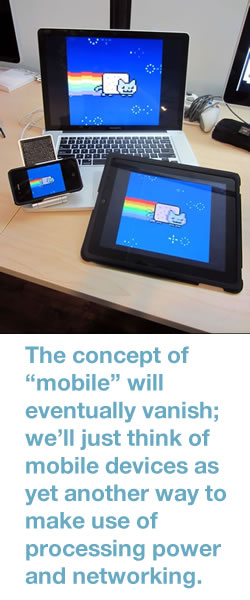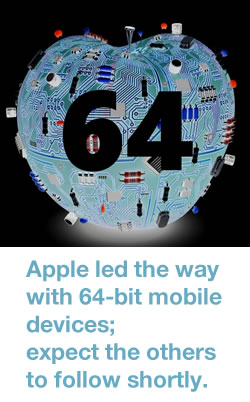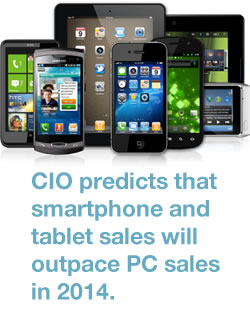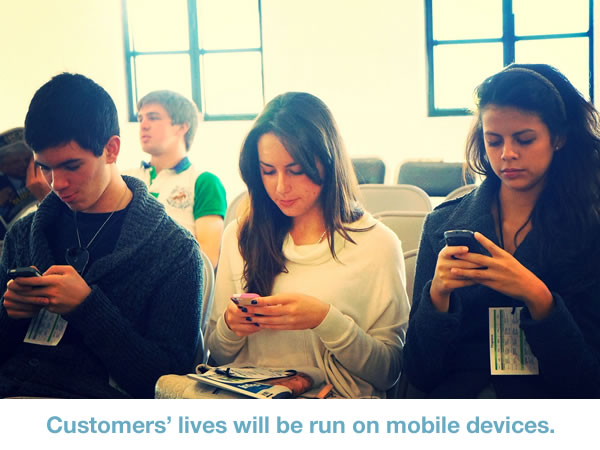
In part one of this series, we looked at predictions for the mobile world for 2014 by CNet (competition is coming), Network World (change is coming, and it’s terrible!), Ericsson Consumer Labs (change is coming, and it’s awesome!), and Google Chairman Eric Schmidt (big data will be the big disruption). Here’s a roundup of more predictions made by tech news outlets for what smartphones, tablets and other mobile technologies will bring this year.
As we said in the previous installment, the true value isn’t in the predictions, but in the way they let us see what people who are either in the mobile industry or who follow it closely are thinking.
ReadWrite: “In 2014, the mobile web will die — and other mobile predictions”
We’re a bit creeped out by a set of predictions that uses the phrase “will die” not once, but twice. ReadWrite’s predictions are all based around mobile devices: what to expect from mobile vendors, and how we’ll perceive and use their wares.
 The “mobile web” — that is, those less-capable, watered-down versions of websites that our mobile devices get redirected to —will die, thanks to mobile browser improvements. Also, the trend towards responsive design, in which a site’s content automatically adjusts itself to work with the size of the screen on the device it’s being viewed with, will continue to grow.
The “mobile web” — that is, those less-capable, watered-down versions of websites that our mobile devices get redirected to —will die, thanks to mobile browser improvements. Also, the trend towards responsive design, in which a site’s content automatically adjusts itself to work with the size of the screen on the device it’s being viewed with, will continue to grow.- After so many predictions of an Apple TV set, ReadWrite have decided to stop giving that rumor life.
- However, they believe that the rumored Apple iWatch will be released in the spring and function as a peripheral device for your iPhone or iPad. They believe that coupled with the iPhone 5S and its M7 motion coprocessor, it’ll be a big hit for fitness and “quantified self” buffs.
- They also believe that Samsung’s lead in smartphones will decline, based on the sales of the Galaxy S4 being only as good as those for its predecessor, the Galaxy S III, the many half-baked features that the S4 has, and their poor, gimmicky software. This may create an opportunity on which other Android vendors may be able to capitalize.
- With better mobile browsers will come more HTML5-compliant sites, which means that more websites will provide the functionality and interactivity that the latest version of HTML makes possible.
- Google Glass was made available only to a select few early adopters last year; this year, ReadWrite expects that them masses will be able to get their paws on it for a retail price of US$299.
- Android will go 64-bit this year, which isn’t much of a surprise as iOS went 64-bit last year. The move to 64-bit means being able to use more than 4GB of RAM, and being able to perform even more computationally-intensive tasks.
- Just as the concept of “multimedia” — the ability to present users with text, pictures, audio, and video — went from a capability that only a few computers had to something we expect from even the cheapest of netbooks, as well as mobile devices, the concept of “mobile” will eventually vanish. After a while, we’ll end up just thinking of smartphones, tablets, and wearables as just another way to make use of processing and networking power, but in forms that aren’t as tied to the desk as desktop and laptop computers are. ReadWrite says it’ll happen in 2014; we think it’ll take longer.
Netbiscuits’ 2014 trend predictions for the mobile web
Creative Commons photo by Esther Vargas. Click to see the source.
Netbiscuits bill themselves as a builder of “software solutions for adaptive mobile web experiences used by brands worldwide”, which clients like PayPal, BMW, Coca-Cola, Procter & Gamble, Viacom, AT&T, and so on. They host over 300,000 mobile web applications that major brands use to interact with their customers, and naturally, their predictions are about the use of mobile technology to grow a customer base. Their predictions come in the form of an infographic.
- Noting the trends in emerging markets, Netbiscuits predict a shift in expectations as more people worldwide will be in a position to acquire their first smartphone. For these people, mobile devices may be their primary (and perhaps even their first) way to access the internet.
- Web applications will have to be more context-sensitive, adjusting themselves to the screen size and device with which they’re being accessed.
- They predict that customers’ lives will be run on mobile, with people fearing not being connected due to low battery power, being out of signal range, or losing their device. In order to stay connected, mobile devices will be augmented with the use of wearables.
- Poor experiences will be punished by customers: this is business 101, but with so many apps and services vying for consumer attention, it’s a buyer’s market, and only those apps and services that provide a consistently good experience will thrive.
- They predict that analytics will be indispensable as customers expect mobile apps and services to customize themselves to meet user needs.
TechSpot’s 10 mobile tech predictions for 2014
Netbiscuits were concerned with mobile software in their 2014 predictions, while TechSpot is all about mobile hardware. Their predictions cover mobile devices and their underlying technology.
 While it’s not clear what advantages a curved display gives to a smartphone (perhaps it’s a better fit to one’s face), it’s a way for a vendor to differentiate their devices. We call these sorts of things “feature spam”, although some consumers may go for it. Expect more phones with large curved OLED displays in the same vein as the Samsung Galaxy Round and the LG Flex.
While it’s not clear what advantages a curved display gives to a smartphone (perhaps it’s a better fit to one’s face), it’s a way for a vendor to differentiate their devices. We call these sorts of things “feature spam”, although some consumers may go for it. Expect more phones with large curved OLED displays in the same vein as the Samsung Galaxy Round and the LG Flex.- Like ReadWrite, TechSpot predict a move towards 64-bit mobile devices. They do note that while iOS is 64-bit ready, much of the libraries that make up Android aren’t, and they expect the Android transition to 64-bit to be slow. Given the relative pokiness with which Android user upgrade operating systems, we expect to see even more Android fragmentation, but now with a 32/64 bit divide along with the fragmentation coming from all those Android versions and skins in use.
- One area in which Nokia’s Lumia series of Windows Phone devices stand out is with their excellent cameras, especially the Lumia 1020’s 41-megapixel sensor. Expect to see other mobile devices race to catch up with this very impressive spec.
- 1080p displays on smartphones already look like paper, but TechSpot have observed that Samsung, LG, and other vendors are working on 1440p displays for smartphones. They predict that many vendors will start showcasing smartphone displays better than 1080p. As they put it: “We’re hesitant to say that including a display on a phone with a resolution beyond 1080p won’t provide any benefits, after many people said the same going from 720p to 1080p.”
- They predict that Windows RT will see even less interest. It makes sense: with Windows 8 and the upcoming Windows 9 being able to run on tablets for just a little more money, why wouldn’t you go with the OS that runs the less-loved “Windows Store” apps and Windows Desktop apps too?
- This one’s so obvious that it barely qualifies as a prediction: LTE everywhere.
- As mobile devices become gaming platforms themselves, Techspot predict that graphics chips on mobile devices will reach console quality this year. The term “console quality” is a bit vague, but perhaps it’s best understood as “providing graphics as least as good as the Xbox 360 or PlayStation 3, if not better”.
- This may be a byproduct of the current economic situation or emerging markets picking up on smartphones and tablets, but they expect that mobile device vendors will continue to address the price-sensitive market and offer less expensive phones.
- Battery technology development is slow work, and it’s expected that we’ll have to make do with our current lithium-ion batteries as no new battery tech is expected this year.
- Techspot predict that more mobile operating systems — most or all of them some kind of Linux derivative — will appear this year. They also predict that these newcomers will not see much success as Android and iOS battle to entrench themselves while Windows Phone, now free of any threat from BlackBerry, looks to solidify its distant-third-place position.
CIO’s 10 mobile tech predictions for 2014
We’ve saved the best-pedigreed predictions for last: CIO’s, which were put together by talking to industry analysts and mobile industry C-level executives. As we said earlier, the true value in these predictions isn’t their accuracy, but the way they let us see what’s top of mind with the people who influence our industry.
 CIO predicts that smartphone and tablet sales will outpace PC sales, citing the IDC figures stating that they expect to see smartphone and tablet sales dwarf PC sales by 250% and PC spending drop 6% this year. Factors driving this include the fact the current mobile device development cycle sees vends putting out a new flagship device every 12 to 18 months, and the fact that for most purposes (and especially general office work), PCs have been on a “good enough” plateau for the past half-dozen years.
CIO predicts that smartphone and tablet sales will outpace PC sales, citing the IDC figures stating that they expect to see smartphone and tablet sales dwarf PC sales by 250% and PC spending drop 6% this year. Factors driving this include the fact the current mobile device development cycle sees vends putting out a new flagship device every 12 to 18 months, and the fact that for most purposes (and especially general office work), PCs have been on a “good enough” plateau for the past half-dozen years.- They predict that the Android/iOS battle will continue this year, with iOS maintaining a 2-to-1 value per unit advantage over Android, while Android will continue with a 3-to-1 device volume presence advantage over iOS. Windows Phone will have to increase developer interest “by 50 to 100 percent” in order to remain a contender.
- They predict that the amount of video viewing that people do on mobile devices will match that on PCs for the first time, and start to rival viewing on TVs and DVRs. Expect video to comprise the lion’s share of mobile bandwidth starting this year.
- Just as PoS (point-of-sale) machines underwent a transformation from cash registers to PCs, they’re now undergoing a similar transformation from PCs to mobile devices. While there are a number of vendors who build mobile device-based PoS systems, IDC predicts that 2014 will be a year of consolidation, as the market matures and makes the transition of one with many players trying to stake their claim, to a smaller number of larger, more stable vendors.
- CIO cites research from electronic payments firm ACI Worldwide, who say that banks will start truly embracing mobile technology, with providing updates not just to mobile devices but wearables, mobile person-to-person payments, and offering “mobile-only experiences” to their customers.
- We think that this is a bit premature, but CA Technologies CTO John Michelsen says that tablets will usher in “the true death of the PC” this year. Michelsen says that this is the year that CIOs and IT will start developing enterprise apps for mobile first, and then adapt them for the desktop…”when necessary”. We may not agree on the timing, but we agree with the metric: the true death of the PC will have taken place when mobile development is the norm and desktop development is the afterthought.
- This prediction is so different from the prevailing wisdom that we couldn’t help but notice it: that SMS will steal the spotlight from apps in 2014. This comes from Steve French, OpenMarket’s VP of Product Management, who says that this app craze will blow over and that “more enterprises in 2014 will increase usage of SMS, especially given consumer and employee familiarity with it.” By that logic, even more people are familiar with telephone voice communication, and that voice should be the big comeback kid, not SMS.
- CIO quotes Stoke’s CEO Vikash Varma in their prediction that LTE security will improve this year, as a response to “more intense cybercrime focus on mobile networks and a rising incidence of hack, such as eavesdropping, man-in-the-middle attacks and packet insertion.”
- They predict the integration of wearables, gamification and mobile payments, which makes sense: the combination of “always on” (in more ways that one), painless payments, and fun makes for a pretty “frictionless” way to extract money from people’s wallets.
- 2014 is the year that mobile and digital currencies go mainstream, with more checkout counters accepting PayPal and Bitcoin, and ubiquitous mobile devices paving the way for digital currency.

